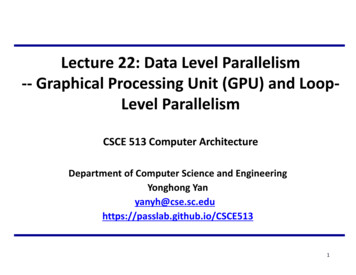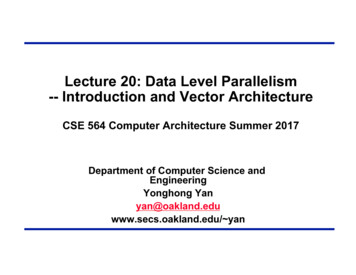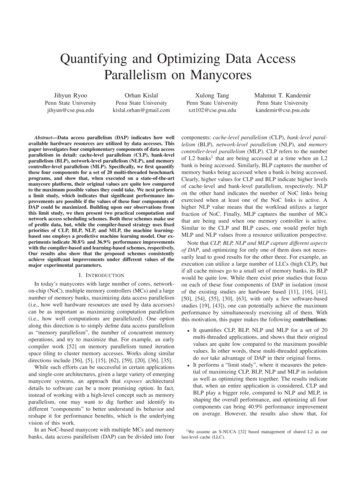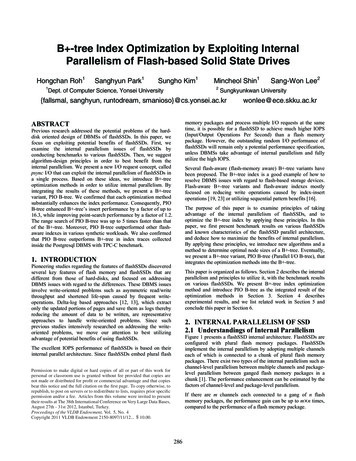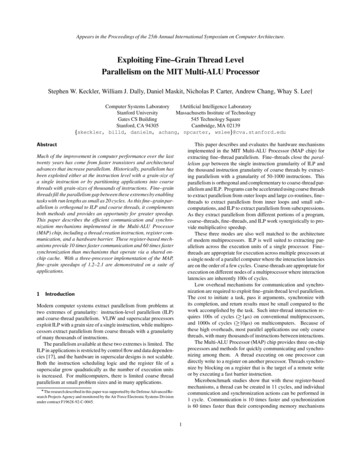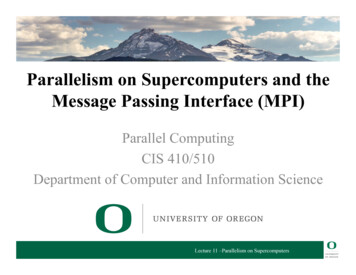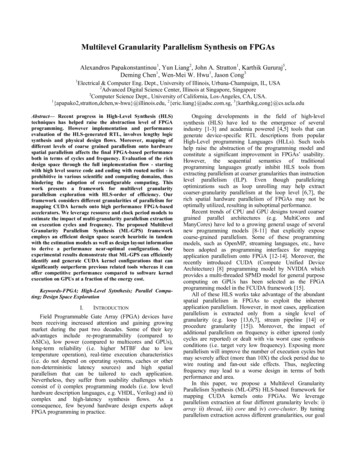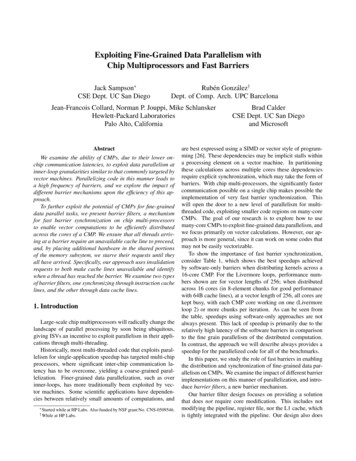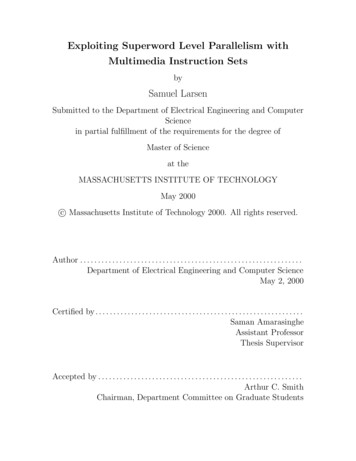
Transcription
Exploiting Superword Level Parallelism withMultimedia Instruction SetsbySamuel LarsenSubmitted to the Department of Electrical Engineering and ComputerSciencein partial fulfillment of the requirements for the degree ofMaster of Scienceat theMASSACHUSETTS INSTITUTE OF TECHNOLOGYMay 2000c Massachusetts Institute of Technology 2000. All rights reserved.Author . . . . . . . . . . . . . . . . . . . . . . . . . . . . . . . . . . . . . . . . . . . . . . . . . . . . . . . . . . . . . .Department of Electrical Engineering and Computer ScienceMay 2, 2000Certified by . . . . . . . . . . . . . . . . . . . . . . . . . . . . . . . . . . . . . . . . . . . . . . . . . . . . . . . . . .Saman AmarasingheAssistant ProfessorThesis SupervisorAccepted by . . . . . . . . . . . . . . . . . . . . . . . . . . . . . . . . . . . . . . . . . . . . . . . . . . . . . . . . .Arthur C. SmithChairman, Department Committee on Graduate Students
Exploiting Superword Level Parallelism with MultimediaInstruction SetsbySamuel LarsenSubmitted to the Department of Electrical Engineering and Computer Scienceon May 2, 2000, in partial fulfillment of therequirements for the degree ofMaster of ScienceAbstractIncreasing focus on multimedia applications has prompted the addition of multimediaextensions to most existing general-purpose microprocessors. This added functionality comes primarily with the addition of short SIMD instructions. Unfortunately,access to these instructions is limited to in-line assembly and library calls. Generally, it has been assumed that vector compilers provide the most promising meansof exploiting multimedia instructions. Although vectorization technology is well understood, it is inherently complex and fragile. In addition, it is incapable of locatingSIMD-style parallelism within a basic block.In this thesis we introduce the concept of Superword Level Parallelism (SLP), anovel way of viewing parallelism in multimedia and scientific applications. We believeSLP is fundamentally different from the loop level parallelism exploited by traditionalvector processing, and therefore demands a new method of extracting it. We havedeveloped a simple and robust compiler for detecting SLP that targets basic blocksrather than loop nests. As with techniques designed to extract ILP, ours is able toexploit parallelism both across loop iterations and within basic blocks. The result isan algorithm that provides excellent performance in several application domains. Inour experiments, dynamic instruction counts were reduced by 46%. Speedups rangedfrom 1.24 to 6.70.Thesis Supervisor: Saman AmarasingheTitle: Assistant Professor2
AcknowledgmentsI want to thank my advisor, Saman Amarasinghe, for initiating this research andfor getting his hands dirty with SUIF passes, LATEX, and takeout. Radu Ruginaprovided his pointer analysis package and added alignment analysis at the same timehe was finishing a paper of his own. Manas Mandal, Kalpesh Gala, Brian Graysonand James Yang at Motorola provided much needed AltiVec development tools andexpertise. Many thanks to Matt Deeds for jumping into the SLP project and forwriting the multimedia kernels used in this thesis. Finally, I want to thank all thepeople who read, critiqued and fixed various versions of this thesis: Krste Asanović,Michael Taylor, Derek Bruening, Mike Zhang, Darko Marinov, Matt Frank, MarkStephenson, Sara Larsen and especially Stephanie Larsen.This research was funded in part by NSF grant EIA9810173 and DARPA grantDBT63-96-C-0036.3
Contents1 Introduction82 Superword Level Parallelism102.1Description of Superword Level Parallelism . . . . . . . . . . . . . . .102.2Vector Parallelism . . . . . . . . . . . . . . . . . . . . . . . . . . . . .112.3Loop Level Parallelism . . . . . . . . . . . . . . . . . . . . . . . . . .142.4SIMD Parallelism . . . . . . . . . . . . . . . . . . . . . . . . . . . . .142.5Instruction Level Parallelism . . . . . . . . . . . . . . . . . . . . . . .153 Optimal SLP Extraction163.1The Graph Problem . . . . . . . . . . . . . . . . . . . . . . . . . . .163.20-1 Integer Linear Programming Solution . . . . . . . . . . . . . . . .183.3Analysis . . . . . . . . . . . . . . . . . . . . . . . . . . . . . . . . . .194 SLP Compiler Algorithm214.1Identifying Adjacent Memory References . . . . . . . . . . . . . . . .224.2Extending the PackSet . . . . . . . . . . . . . . . . . . . . . . . . . .264.3Combination . . . . . . . . . . . . . . . . . . . . . . . . . . . . . . . .274.4Scheduling . . . . . . . . . . . . . . . . . . . . . . . . . . . . . . . . .285 A Simple Vectorizing Compiler306 SLP Compiler Implementation336.1Loop Unrolling . . . . . . . . . . . . . . . . . . . . . . . . . . . . . .433
6.2Redundant load elimination . . . . . . . . . . . . . . . . . . . . . . .356.3Array Padding. . . . . . . . . . . . . . . . . . . . . . . . . . . . . .356.4Alignment Analysis . . . . . . . . . . . . . . . . . . . . . . . . . . . .366.5Flattening . . . . . . . . . . . . . . . . . . . . . . . . . . . . . . . . .366.6Dataflow Optimizations. . . . . . . . . . . . . . . . . . . . . . . . .376.7Superword Level Parallelization . . . . . . . . . . . . . . . . . . . . .377 Results387.1Benchmarks . . . . . . . . . . . . . . . . . . . . . . . . . . . . . . . .387.2SLP Availability. . . . . . . . . . . . . . . . . . . . . . . . . . . . .397.2.1SLP Heuristic . . . . . . . . . . . . . . . . . . . . . . . . . . .397.2.2Heuristic vs. Linear Programming Methods . . . . . . . . . .407.2.3SLP vs. Vector Extraction . . . . . . . . . . . . . . . . . . . .41SLP Performance . . . . . . . . . . . . . . . . . . . . . . . . . . . . .437.38 Architectural Support for SLP459 Conclusion47A Multimedia Kernels525
List of Figures2-1 Isomorphic statements. . . . . . . . . . . . . . . . . . . . . . . . . . .112-2 Comparison of SLP and vector parallelization techniques. . . . . . . .122-3 Example of an unvectorizable code sequence. . . . . . . . . . . . . . .143-1 Example graph representing packing possibilities. . . . . . . . . . . .174-1 Example of SLP analysis. . . . . . . . . . . . . . . . . . . . . . . .234-2 Pseudo code for the SLP extraction algorithm. . . . . . . . . . . . . .244-3 Pseudo code for the SLP extraction helper functions. . . . . . . . . .254-4 Example of multiple packing possibilities. . . . . . . . . . . . . . . . .274-5 Example of a dependence between groups of packed statements. . . .285-1 Pseudo code for the vector extraction algorithm. . . . . . . . . . . . .316-1 Compiler flow. . . . . . . . . . . . . . . . . . . . . . . . . . . . . . . .347-1 Dynamic instructions eliminated using the SLP heuristic. . . . . . . .407-2 Comparison of SLP and vector methods. . . . . . . . . . . . . . . . .427-3 Contribution of vectorizable and non-vectorizable code sequences. . .427-4 Percentage improvement of execution time on an MPC7400. . . . . .44A-1 VMM: Vector-matrix multiply. . . . . . . . . . . . . . . . . . . . . . .52A-2 MMM: Matrix-matrix multiply. . . . . . . . . . . . . . . . . . . . . .53A-3 FIR: Finite impulse response filter. . . . . . . . . . . . . . . . . . . .54A-4 IIR: Infinite impulse response filter. . . . . . . . . . . . . . . . . . . .55A-5 YUV: RGB to YUV conversion. . . . . . . . . . . . . . . . . . . . . .566
List of Tables3.1Linear programming problem sizes. . . . . . . . . . . . . . . . . . . .193.2Dynamic instructions eliminated using linear programming methods.207.1Multimedia kernels. . . . . . . . . . . . . . . . . . . . . . . . . . . . .387.2Dynamic instructions eliminated using the SLP heuristic. . . . . . . .397.3Comparison of SLP heuristic and linear programming methods. . . .417.4Comparison of SLP and vector methods. . . . . . . . . . . . . . . . .417.5Speedup on an MPC7400 processor using SLP compilation.437. . . . .
Chapter 1IntroductionThe recent shift toward computation-intensive multimedia workloads has resulted ina variety of new multimedia extensions to current microprocessors [8, 12, 18, 20, 22].Many new designs are targeted specifically at the multimedia domain [3, 9, 13]. Thistrend is likely to continue as it has been projected that multimedia processing willsoon become the main focus of microprocessor design [10].While different processors vary in the type and number of multimedia instructionsoffered, at the core of each is a set of short SIMD (Single Instruction Multiple Data)or superword operations. These instructions operate concurrently on data that arepacked in a single register or memory location. In the past, such systems couldaccommodate only small data types of 8 or 16 bits, making them suitable for a limitedset of applications. With the emergence of 128-bit superwords, new architectures arecapable of performing four 32-bit operations with a single instruction. By addingfloating point support as well, these extensions can now be used to perform moregeneral-purpose computation.It is not surprising that SIMD execution units have appeared in desktop microprocessors. Their simple control, replicated functional units, and absence of heavilyported register files make them inherently simple and extremely amenable to scaling.As the number of available transistors increases with advances in semiconductor technology, datapaths are likely to grow even larger.Today, use of multimedia extensions is difficult since application writers are largely8
restricted to using in-line assembly routines or specialized library calls. The problemis exacerbated by inconsistencies among different instruction sets. One solution to thisinconvenience is to employ vectorization techniques that have been used to parallelizescientific code for vector machines [7, 16, 17]. Since a number of multimedia applications are vectorizable, this approach promises good results. However, many importantmultimedia applications are difficult to vectorize. Complicated loop transformationtechniques such as loop fission and scalar expansion are required to parallelize loopsthat are only partially vectorizable [2, 5, 19]. Consequently, no commercial compilercurrently implements this functionality. This thesis presents a method for extractingSIMD parallelism beyond vectorizable loops.We believe that short SIMD operations are well suited to exploit a fundamentallydifferent type of parallelism than the vector parallelism associated with traditionalvector and SIMD supercomputers. We denote this parallelism Superword Level Parallelism (SLP) since it comes in the form of superwords containing packed data. Vectorsupercomputers require large amounts of parallelism in order to achieve speedups,whereas SLP can be profitable when parallelism is scarce. From this perspective, wehave developed a general algorithm for detecting SLP that targets basic blocks ratherthan loop nests.In some respects, superword level parallelism is a restricted form of ILP. ILPtechniques have been very successful in the general-purpose computing arena, partlybecause of their ability to find parallelism within basic blocks. In the same way thatloop unrolling translates loop level parallelism into ILP, vector parallelism can betransformed into SLP. This realization allows for the parallelization of vectorizableloops using the same basic block analysis. As a result, our algorithm does not requireany of the complicated loop transformations typically associated with vectorization.In fact, Chapter 5 will show that vector parallelism alone can be uncovered using asimplified version of the SLP compiler algorithm presented in Chapter 4.9
Chapter 2Superword Level ParallelismThis chapter begins by elaborating on the notion of SLP and the means by which it isdetected. Terminology is introduced that facilitates the discussion of our algorithmsin Chapters 4 and 5. We then contrast SLP to other forms of parallelism and discusstheir interactions. This helps motivate the need for a new compilation technique.2.1Description of Superword Level ParallelismSuperword level parallelism is defined as short SIMD parallelism in which the sourceand result operands of a SIMD operation are packed in a storage location. Detectionis done through a short, simple analysis in which independent isomorphic statementsare identified within a basic block. Isomorphic statements are those that contain thesame operations in the same order. Such statements can be executed in parallel bya technique we call statement packing, an example of which is shown in Figure 21. Here, source operands in corresponding positions have been packed into registersand the addition and multiplication operators have been replaced by their SIMDcounterparts. Since the result of the computation is also packed, unpacking may berequired depending on how the data are used in later computations. The performancebenefit of statement packing is determined by the speedup gained from parallelizationminus the cost of packing and unpacking.Depending on what operations an architecture provides to facilitate general pack10
adrwadrw besxbesx cfty****z[i 0]z[i 1]z[i 2]z[i 3]cfty SIMD* SIMDz[i 0]z[i 1]z[i 2]z[i 3]Figure 2-1: Isomorphic statements that can be packed and executed in parallel.ing and unpacking, this technique can actually result in a performance degradationif packing and unpacking costs are high relative to ALU operations. One of the mainobjectives of our SLP detection technique is to minimize packing and unpacking bylocating cases in which packed data produced as a result of one computation can beused directly as a source in another computation.Packed statements that contain adjacent memory references among correspondingoperands are particularly well suited for SLP execution. This is because operands areeffectively pre-packed in memory and require no reshuffling within a register. Inaddition, an address calculation followed by a load or store need only be executedonce instead of individually for each element. The combined effect can lead to asignificant performance increase. This is not surprising since vector machines havebeen successful at exploiting the same phenomenon. In our experiments, instructionseliminated from operating on adjacent memory locations had the greatest impact onspeedup. For this reason, locating adjacent memory references forms the basis of ouralgorithm, discussed in Chapter 4.2.2Vector ParallelismTo better explain the differences between superword level parallelism and vector parallelism, we present two short examples, shown in Figures 2-2 and 2-3. Although thefirst example can be molded into a vectorizable form, we know of no vector compilers11
for (i 0; i 16; i ) {localdiff ref[i] - curr[i];diff abs(localdiff);}(a) Original loop.for (i 0; i 16; i ) {T[i] ref[i] - curr[i];}for (i 0; i 16; i ) {diff abs(T[i]);}(b) After scalar expansion and loop fission.for (i 0; i 16; i 4) {localdiff ref[i 0] - curr[i 0];diff abs(localdiff);localdiff ref[i 1] - curr[i 1];diff abs(localdiff);localdiff ref[i 2] - curr[i 2];diff abs(localdiff);localdiff ref[i 3] - curr[i 3];diff abs(localdiff);}(c) Superword level parallelism exposed after unrolling.for (i 0; i 16; i 4) {localdiff0 ref[i 0]localdiff1 ref[i 1]localdiff2 ref[i 2]localdiff3 ref[i 3]diffdiffdiffdiff -curr[i 0];curr[i 1];curr[i 2];curr[i ;abs(localdiff3);}(d) Packable statements grouped together after renaming.Figure 2-2: Comparison of SLP and vector parallelization techniques.12
that can be used to vectorize the second. Furthermore, the transformations requiredin the first example are unnecessarily complex and may not work in more complicated circumstances. In general, a vector compiler must employ a repertoire of toolsin order to parallelize loops on a case by case basis. By comparison, our method issimple and robust, yet still capable of detecting the available parallelism.Figure 2-2(a) presents the inner loop of the motion estimation algorithm usedfor MPEG encoding. Vectorization is inhibited by the presence of a loop-carrieddependence and a function call within the loop body. To overcome this, a vectorcompiler can perform a series of transformations to mold the loop into a vectorizableform. The first is scalar expansion, which allocates a new element in a temporary arrayfor each iteration of the loop [5]. Loop fission is then used to divide the statementsinto separate loops [15]. The result of these transformations is shown in Figure 2-2(b).The first loop is vectorizable, but the second must be executed sequentially.Figure 2-2(c) shows the loop from the perspective of SLP. After unrolling, the fourstatements corresponding to the first statement in the original loop can be packedtogether. The packing process effectively moves packable statements to contiguouspositions, as shown in part (d). The code motion is legal because it does not violateany dependences (once scalar renaming is performed). The first four statements inthe resulting loop body can be packed and executed in parallel. Their results are thenunpacked so they can be used in the sequential computation of the final statements.In the end, this method has the same effect as the transformations used for vectorcompilation, while only requiring loop unrolling and scalar renaming.Figure 2-3 shows a code segment that averages the elements of two 16x16 matrices.As is the case with many multimedia kernels, our example has been hand-optimizedfor a sequential machine. In order to vectorize this loop, a vector compiler would needto reverse the programmer-applied optimizations. Were such methods available, theywould involve constructing a for loop, restoring the induction variable, and re-rollingthe loop. In contrast, locating SLP within the loop body is simple. Since the optimized code is amenable to SLP analysis, hand-optimization has had no detrimentaleffects on our ability to detect the available parallelism.13
do {dst[0]dst[1]dst[2]dst[3] (src1[0](src1[1](src1[2](src1[3] src2[0])src2[1])src2[2])src2[3]) 1;1;1;1;dst 4;src1 4;src2 4;}while (dst ! end);Figure 2-3: Example of an unvectorizable code sequence.2.3Loop Level ParallelismVector parallelism, exploited by vector computers, is a subset of loop level parallelism.General loop level parallelism is typically exploited by a multiprocessor or MIMDmachine. In many cases, parallel loops may not yield performance gains because offine-grain synchronization or loop-carried communication. It is therefore necessaryto find coarse-grain parallel loops when compiling for MIMD machines. Traditionally, a MIMD machine is composed of multiple microprocessors. It is conceivablethat loop level parallelism could be exploited orthogonally to superword level parallelism within each processor. Since coarse-grain parallelism is required to get goodMIMD performance, extracting SLP should not detract from existing MIMD parallelperformance.2.4SIMD ParallelismSIMD parallelism came into prominence with the advent of massively parallel supercomputers such as the Illiac IV [11], and later with the Thinking Machines CM-1and CM-2 [25, 26] and the Maspar MP-1 [4, 6]. The association of the term “SIMD”with this type of computer is what led us to use “Superword Level Parallelism” whendiscussing short SIMD operations.SIMD supercomputers were implemented using thousands of small processors that14
worked synchronously on a single instruction stream. While the cost of massive SIMDparallel execution and near-neighbor communication was low, distribution of data tothese processors was expensive. For this reason, automatic SIMD parallelizationcentered on solving the data distribution problem [1]. In the end, the class of applications for which SIMD compilers were successful was even more restrictive than thatof vector and MIMD machines.2.5Instruction Level ParallelismSuperword level parallelism is closely related to ILP. In fact, SLP can be viewed as asubset of instruction level parallelism. Most processors that support SLP also supportILP in the form of superscalar execution. Because of their similarities, methods forlocating SLP and ILP may extract the same information. Under circumstances wherethese types of parallelism completely overlap, SLP execution is preferred because itprovides a less expensive and more energy efficient solution.In practice, the majority of ILP is found in the presence of loops. Therefore,unrolling the loop multiple times may provide enough parallelism to satisfy bothILP and SLP processor utilization. In this situation, ILP performance would notnoticeably degrade after SLP is extracted from a program.15
Chapter 3Optimal SLP ExtractionWe initially formulated SLP extraction as a graph problem. From there, we deriveda set of 0-1 integer linear programming equations that could be used to find the bestset of packed statements for a given basic block. Although this technique proved intractable for real benchmarks, we gained valuable insights that helped in the discoveryof the heuristic algorithm described in the next chapter.3.1The Graph ProblemFor any statement in a basic block, there is the possibility for several different packingoptions. These options can be represented as nodes in a graph. Each node has anassociated value that indicates the savings achieved when compared to the sequentialalternative. Savings are computed from the type and number of operations withineach statement, the number of statements in the packed group, and any necessarypacking or unpacking costs. Packing costs will often produce nodes that are assignednegative savings. Such nodes are only profitable when considered in the context ofother packed groups. This notion is captured by graph edges. Edges are drawnbetween two nodes whenever data produced in one node can be used in the other. Avalue is associated with each edge as well, indicating the packing cost recovered whencommunicated data are in a useful packed configuration.An example graph is shown in Figure 3-1. Savings have been omitted since they16
a b cd e fg h jk a * mn d * pq g * ra b cd e fg h jk a * mn d * pq g * ra b cd e fk a * mn d * pa b cg h jk a * mq g * rd e fg h jn d * pq g * rFigure 3-1: Example graph representing packing possibilities.are architecture-dependent and not pertinent to this discussion. Also, only differentstatement combinations are shown. In reality, all permutations are possible. Thismeans that a basic block with n isomorphic statements will result in a graph withn!/(n k)! nodes, where k is the number of operands that can be accommodated ona given superword datapath.Choosing the set of nodes and edges with the greatest sum value determines thebest packing configuration. If the sum is negative, the entire basic block should be leftunparallelized. Since many nodes contain duplicate statements, care must be takento ensure that savings are not counted more than once. We make the simplifyingassumption that it is never profitable to execute any statement twice. Therefore, themaximization process is restricted such that only one node can be chosen from anyoverlapping group.The example in Figure 3-1 attempts to relate the size and complexity of a graphconstructed from even a small basic block. The problem is intensified when: Statements are flattened into three-address form, creating an enormous numberof statements with common operations. Inner loops are unrolled to expose parallelism, increasing the size of basic blocks.17
Small data types allow a large number of statements in a packed group, andtherefore more possible statement permutations.Under these circumstances, the resulting graphs become unmanageable.3.20-1 Integer Linear Programming SolutionGiven a graph G hV, Ei, as described in the previous section, the best possiblesavings can be calculated using 0-1 integer linear programming as follows:For a set of nodes:v1 , ., vn V , with associated savings sv1 , ., svn Int,we assign a corresponding set of binary variables:x1 , ., xn {0, 1}For a set of edges:e1 , ., em E, with associated savings se1 , ., sem Int,we assign a corresponding set of binary variables:y1 , ., ym {0, 1}The objective function is then given by: maximize nXs v i · xi i 1mXj 1 sej · y j subject to the following constraints: vi , vj V where i 6 j and vi , vj share a common statement, (xi xj 1)and18
pluTerms in theobjective ber 3610,996,62852Table 3.1: Linear programming problem size for the most time-instensive basic blockin each SPEC95fp benchmark. Input files could not be generated for fpppp andwave5. ek E where ek connects vi and vj , (xi xj 2yk 0)This maximizes the savings obtained by summing the values associated with eachchosen node and edge. A node or edge is chosen when its corresponding binaryvariable has a value of 1 in the optimal solution. The first set of constraints allowsonly one node to be chosen from a group of overlapping nodes. The second set ofconstraints are needed to force the selection of two nodes when the edge betweenthem is chosen.3.3AnalysisWe evaluated the system described above on the SPEC95fp benchmark suite. Testswere run using the CPLEX linear programming solver running on a 4-processor Alpha4100 Cluster with 2Gb of memory. When basic blocks were flattened into threeaddress form, our system was unable to generate CPLEX input files before exhaustingavailable memory. Without flattening, input files could be generated for eight of theten benchmarks. Table 3.1 shows input file sizes for the most time-intensive basicblocks.Of these eight benchmarks, only mgrid, hydro2d and applu were solvable within24 hours. In an attempt to produce results for the remaining benchmarks, we limitedpacking choices to sets of eight statements. Each statement’s set was determined byits position in the original basic block. Adding this constraint forced the size of each19
b3dapplu% 0%14.82%19.67%Table 3.2: Percentage of dynamic instructions eliminated with integer linear programming methods on a hypothetical 256-bit superword datapath. It is assumed that four64-bit floating point operations can be executed in parallel.problem to be linearly proportional to the size of the basic block. With this restriction,we were able to generate results for every benchmark except fpppp. Table 3.2 lists thenumber of dynamic instructions eliminated from each benchmark assuming a 256-bitdatapath. Results were gathered by instrumenting source code with counters in orderto determine the number of times each basic block was executed. These numbers werethen multiplied by the number of static instructions in each basic block.While the SLP extraction methods presented in this chapter proved infeasible,our results allowed us to glean three high-level concepts. First, it was apparent thatsuperword level parallelism was abundant in our benchmark set, we simply neededa viable method of extracting it. Second, statement packing appeared to be moresuccessful when performed on three-address form since packing could be done atthe level of subexpressions. Finally, we found that packed statements with adjacentmemory references had the biggest potential impact on performance. As a result, theheuristic solution described in the next chapter begins by locating adjacent memoryreferences.20
Chapter 4SLP Compiler AlgorithmThis chapter describes the core algorithm developed for extracting superword levelparallelism from a basic block. The algorithm can be neatly divided into four phases:adjacent memory identification, PackSet extension, combination and scheduling. Adjacent memory identification uncovers an initial set of packed statements with references to adjacent memory. PackSet extension then constructs new groups basedon this initial seed. Combination merges all groups into sizes consistent with thesuperword datapath width. Finally, scheduling replaces groups of packed statementswith new SIMD operations.In the discussion of our algorithm, we assume a target architecture without support for unaligned memory accesses. In general, this means that merging operationsmust be emitted for every wide load and store. These operations combine data fromtwo consecutive aligned segments of memory in order to simulate an unaligned memory access. Alignment analysis attempts to subvert this added cost by staticallydetermining the address alignment of each load and store instruction. When successful, we can tailor packing decisions so that memory accesses never span an alignmentboundary. Alignment analysis is described in Chapter 6. For now, we assume thateach load and store instruction has been annotated with alignment information whenpossible.21
4.1Identifying Adjacent Memory ReferencesBecause of their obvious impact, statements containing adjacent memory referencesare the first candidates for packing. We therefore begin our analysis by scanning eachbasic block to find independent pairs of such statements. Adjacency is determinedusing both alignment information and array analysis.In general, duplicate memory operations can introduce several different packingpossibilities. Dependences will eliminate many of these possibilities and redundantload elimination will usually remove the rest. In practice, nearly every memory reference is directly adjacent to at most two other references. These correspond to thereferences that access memory on either side of the reference in question. Whenlocated, the first occurrence of each pair is added to the PackSet.Definition 4.1.1 A Pack is an n-tuple, hs1 , ., sn i, where s1 , ., sn are independentisomorphic statements in a basic block.Definition 4.1.2 A PackSet is a set o
2.1 Description of Superword Level Parallelism Superword level parallelism is de ned as short SIMD parallelism in which the source and result operands of a SIMD operation are packed in a storage location. Detection is done through a short, simple analysis in which independent isomorphic statements are identi ed within a basic block.
